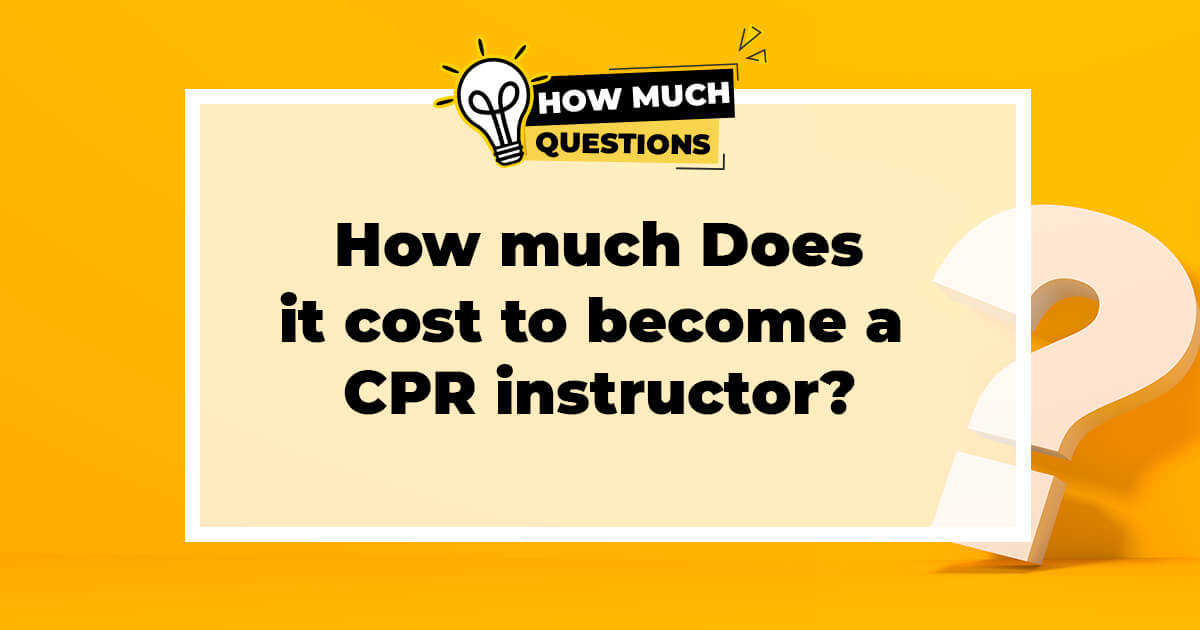How much does it cost to become a CPR instructor?
Discover the expenses involved in pursuing a career as a CPR instructor. Uncover key factors that influence costs and find cost-saving tips to embark on this rewarding journey.

Introduction
Becoming a CPR instructor can be a fulfilling career path, but it's crucial to understand the financial aspects involved. In this guide, we'll break down the various factors influencing the cost of becoming a CPR instructor. Whether you're considering this career for personal growth or as a profession, we'll provide insights to help you make informed decisions.
How Much Does It Cost to Become a CPR Instructor?
Becoming a CPR instructor is an investment in both time and money. On average, the total cost to become a CPR instructor ranges between $400 to $935. This cost encompasses:
- CPR Provider Certification: $75-$150
- AHA Instructor Essentials Online Course: $35
- Instructor Hands-on/Classroom Course: $250-$600
- Monitoring: $0-$150 (Some Training Centers may include this in the classroom course cost)
It's important to note that after completing the instructor course, there might be additional expenses for renting or purchasing equipment to teach classes. However, the initial investment can typically be recouped after teaching just 2-3 CPR courses.
Factors Influencing Cost
Training Programs
CPR instructor training programs come in various forms and lengths, each with its associated costs. We'll delve into the differences between basic and advanced programs and discuss the price variations.
Certification Fees
To become a certified CPR instructor, you'll need to pay certification fees. We'll explore the costs of certification from reputable organizations and how they can impact your overall expenses.
Materials and Resources
From textbooks to training manikins, there are essential materials required for CPR instructor training. We'll outline what materials you might need and offer guidance on where to find them cost-effectively.
Renewal and Maintenance
Maintaining your CPR instructor certification involves periodic renewal fees and ongoing education. We'll provide insights into the long-term financial commitments associated with staying certified.
Pre-Purchase Considerations
Career Goals
Determine your career goals as a CPR instructor. Are you looking to work part-time, full-time, or volunteer? Your goals will influence the level of training and certification you pursue.
Accreditation
Not all CPR instructor programs are created equal. We'll discuss the importance of choosing accredited training programs and how it can impact your career prospects and earnings.
Equipment Investment
Consider the equipment you'll need for teaching CPR. We'll help you make an informed decision on whether to invest upfront or gradually acquire the necessary tools.
Location and Market
The cost of becoming a CPR instructor can vary by location and market demand. We'll analyze regional price differences and provide tips for navigating these variables.
Cost-Saving Tips
Scholarships and Grants
Explore opportunities for financial aid through scholarships and grants designed to support CPR instructor trainees.
Group Discounts
If you're pursuing CPR instructor training with colleagues or friends, discover how group discounts can significantly reduce your overall costs.
Secondhand Resources
Consider buying secondhand textbooks and equipment to save money without compromising quality and safety.
Guidance for Optimal Choices
Long-Term Career Planning
We'll offer guidance on aligning your CPR instructor training with long-term career goals and potential income prospects.
Networking
Building a professional network can open doors to job opportunities and potential collaborations. Learn how networking can impact your CPR instructor career.
Conclusion
In conclusion, the cost of becoming a CPR instructor can vary widely depending on several factors. By considering your career goals, exploring cost-saving options, and making informed choices, you can embark on this rewarding journey confidently. Remember that the key to success lies not only in managing costs but also in maintaining the highest standards of CPR instruction.
This article is intended for informational purposes only. It is essential to seek professional advice and conduct thorough research before making any financial decisions related to becoming a CPR instructor.
FAQ: Frequently Asked Questions
How much does it cost to become a CPR instructor?
Becoming a CPR instructor typically costs between $400 to $935. This includes the costs of the prerequisite certification, required manuals, and the instructor course itself.
What are the components of the cost?
The breakdown of the costs is as follows:
- CPR Provider Certification: $75-$150
- AHA Instructor Essentials Online Course: $35
- Instructor Hands-on/Classroom Course: $250-$600
- Monitoring: $0-$150
Is there any additional cost after the instructor course?
Yes, after completing the instructor course, you might need to rent or purchase equipment to teach classes. The cost of this equipment should be considered when budgeting.
How long does the CPR instructor course take?
The hands-on classroom portion of the instructor course typically takes about 8 hours. However, before attending this, you'll need to complete the AHA online Instructor Essentials course, which takes approximately 1.25 hours.
Can I take the CPR instructor course online?
Online instructor classes are not currently allowed with the American Heart Association. They did permit online instructor courses between 2020-2022, but these courses must now be taught in person.
What is the difference between BLS and Heartsaver Instructors?
BLS (Basic Life Support) is a more advanced level of CPR for Healthcare Providers. Some CPR Instructor Classes will be ‘Heartsaver CPR Instructor’ classes which only require basic Heartsaver CPR certification. It's less common to find these courses as most people want to teach both types of CPR courses.
Is medical experience required to become a CPR instructor?
While many CPR instructors have a background in the medical field, it is not a requirement. Medical experience can be beneficial for understanding course content, but there are no mandatory qualifications needed.
How can I start my CPR Instructor course?
You'll need to find an authorized AHA Training Center offering instructor classes. They will guide you through the process, which includes filling out an Instructor Candidate Application.
Is there an exam for CPR instructors?
Yes, at the end of the instructor course, there's a 25-question exam. The AHA requires a score of 84% or higher to pass.
How soon should I teach a class after becoming an instructor?
It's recommended to teach a class within the first six months of completing the instructor's course to ensure the skills learned are still fresh.
If you want to know other articles similar to How much does it cost to become a CPR instructor? you can visit the category Consultation and Professional Training.
- Introduction
- How Much Does It Cost to Become a CPR Instructor?
- Factors Influencing Cost
- Pre-Purchase Considerations
- Cost-Saving Tips
- Guidance for Optimal Choices
- Conclusion
- FAQ: Frequently Asked Questions
- How much does it cost to become a CPR instructor?
- What are the components of the cost?
- Is there any additional cost after the instructor course?
- How long does the CPR instructor course take?
- Can I take the CPR instructor course online?
- What is the difference between BLS and Heartsaver Instructors?
- Is medical experience required to become a CPR instructor?
- How can I start my CPR Instructor course?
- Is there an exam for CPR instructors?
- How soon should I teach a class after becoming an instructor?


Leave a Reply